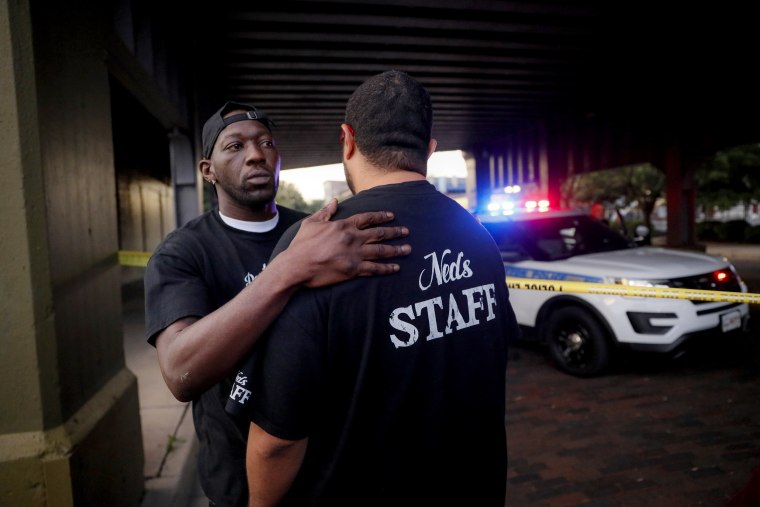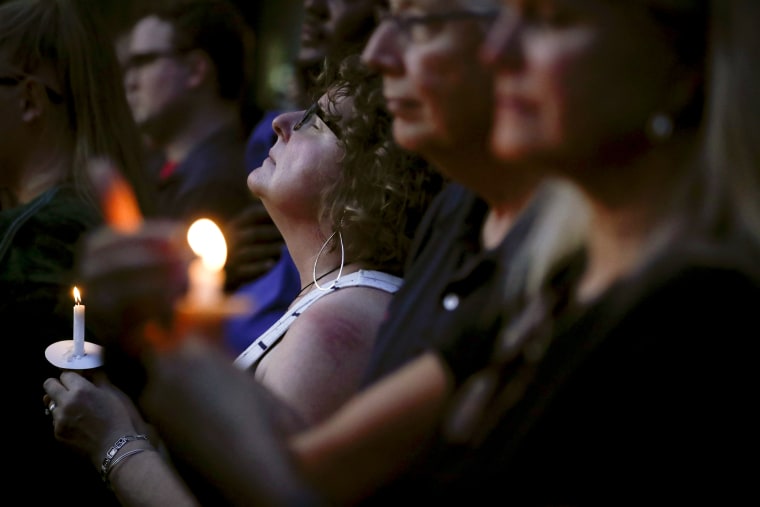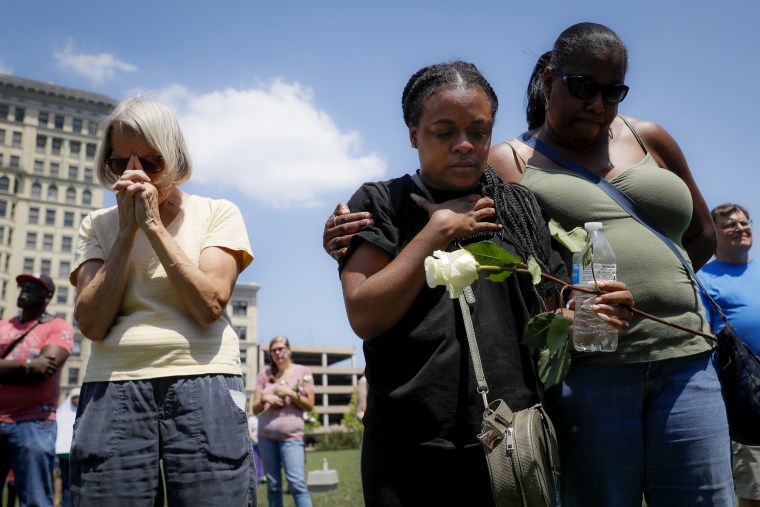DAYTON, Ohio — First there was the Ku Klux Klan rally in May. Just days later, ferocious tornadoes cut a deadly swath through the region. Then early Sunday morning came the latest tragedy to pull together this blue-collar city of 140,000.
A gunman killed at least nine people and injured 27 outside of Ned Peppers Bar on East Fifth Street, a corridor humming with lively restaurants and watering holes most nights.
Hours later, yellow caution tape blocked the street but failed to ward off people who had to see it for themselves: the scene of another mass shooting in America, this one coming less than 24 hours after one in El Paso, Texas.
The bloodshed fractured residents' perception of the 12-block strip, what some call "little Bourbon Street" and where revelers can indulge in a stuffed burger at Blind Bob's and dance the night away at Ned Peppers.
In minutes, Dayton's historic Oregon District went from a carefree corner of the city to a horrific scene of deadly violence.
David Cron, 58, wearing a T-shirt emblazoned with "Dayton Strong," watched late Sunday afternoon as firefighters in clean-up mode unleashed a torrent of water from a hose onto the street. Cron said he bought the shirt to help victims of the tornadoes that tore through the area this spring.
"I'm not here to gawk, but to feel as part of the community," Cron said. "Who would have known this would be the place they'd be washing blood off the sidewalk?"

Two days before the twisters struck, the city braced for the threat of violence when nine members of the Ku Klux Klan held a rally downtown. The Klan was met by more than 500 counter-protesters. In the end, no one was arrested and no force was needed.
Cron, a Dayton native, remembered how businesses on Fifth Street banded together, papering their windows with signs that read, "You are not welcome here" and "Take your hatin' out of Dayton."
"Down here, everyone comes together," he said.
Dayton's neighborhoods may still be divided along racial lines as one of the nation's most racially segregated cities, a legacy underscored by race riots in the 1960s, but on East Fifth Street, locals say people of all persuasions rub shoulders. College students mingle with aging hippies on weekend nights. In the summer, musicians wail on guitars and fire breathers entertain passersby on the street paved with red brick.
Cron was tending bar overnight not far from Fifth Street and would have normally walked through the area on his way home just before the gunshots rang out around 1 a.m. But he was exhausted and he opted for the bus.
"You think about those people who will never get to go home," he said.
A man who said one of the victims, Thomas McNichols, 25, was his cousin, cried in front of television cameras blocks from the shooting as he pleaded for President Donald Trump to stop this from happening again.
"I want the president to hear this: You can sit on Twitter all day, but you're not here," the man said. "Where are you at Donald Trump?"
At a vigil later Sunday night for the victims, a large crowd chanted, "Do something!" and "Make a change," while Ohio Gov. Mike DeWine spoke. DeWine, a Republican, offered his condolences to the victims' families.
The mass shooting Saturday at a Walmart in El Paso, where a gunman killed 20 people and injured 26 others, was still fresh on the minds of many in Dayton that night.
Kate Horsley had finished her waitressing shift at the restaurant Thai 9 when she and her co-workers decided to unwind at The Trolley Stop, a tavern on Fifth Street. The TV news in all the bars was focused on El Paso.

Everything came to a halt when gunfire reverberated a block away, Horsley said. Terrified patrons huddled together, and the doors at The Trolley Stop were locked.
Police who regularly patrol the Oregon District killed the gunman, identified as a 24-year-old white man, within minutes of the first shots being fired, authorities said. A motive remained unclear late Sunday, but one of the victims was his 22-year-old sister.
Most of the victims were in their 20s and 30s and had been shot as the gunman, clad in body armor and carrying 100-round capacity magazines, headed for Ned Peppers Bar, said Dayton Police Chief Richard S. Biehl.
Police stopped him before he got inside.
"Had this individual made it through the doorway of Ned Peppers with that level of weaponry, there would have been a catastrophic level of injury and loss of life," Biehl said at a news conference.
Horsley, who returned to work Sunday, said she was grateful the police acted so quickly, calling the events of the past few months — from the Klan rally to the tornadoes to the mass shooting — a "triple whammy" for Dayton.
"It's not been the best year for us," Horsley said as she helped to pass out free cups of water and Styrofoam containers of chicken fried rice from her restaurant to police, firefighters and onlookers on the scene Sunday afternoon. A car radio blared R.E.M.'s "Everybody Hurts."
"It's been back to back to back," Horsley said. "When will it end?"
Charles Lee Mcglothan, 60, bore the same feeling of helplessness as he stood with a single white rose in front of the yellow police tape, which would be removed before Sunday night's vigil.
Mcglothan, a retired Army staff sergeant, said he didn't often come to East Fifth Street.
"My partying days are behind me," he said, adding that he appreciated how the bricked street reminded him of his time stationed in Germany.

He returned to his native Dayton in 2003, raising children in the area and remarrying.
"Dayton has had its ups and downs," said Mcglothan, who works handling materials in a warehouse.
One of the "downs" has been its population decline since its heyday as a major manufacturing center and General Motors' decision more than 10 years ago to shutter a plant in nearby Moraine.
But Mcglothan said he is confident Dayton will bounce back after the shooting. While the victims' memories must be honored, his "little Bourbon Street" will roar again when the time is appropriate, he said.
"Terrorists want to change your lifestyle," he said, cradling the white rose in his hand as it fell limp in the summer heat. "We won't let them."

